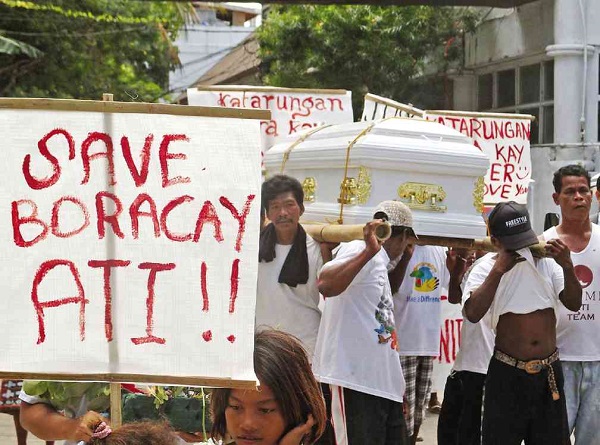Today is the UN’s Day of the World’s Indigenous Peoples, and to mark the date we are sharing the story of the plight of the Ati people on Boracay Island in the Philippines. This article was originally published in March, 2013.
Boracay Island in the Philippines was voted in 2012 as “the world’s best island” by international travel magazines, and ranked “Asia’s #1 beach” by Trip Advisor in 2013. Powder white sands and turquoise blue waters have long painted this tropical paradise.
“Like an ambitious and beautiful pageant winner unwilling to relinquish her crown, Boracay primps and preens year after year to stay the trophy beach of the Philippines,” writes the Lonely Planet.
This dreamy island-resort is perfect for soaking in the endless sun, and for the night parties that never sleep. It knows no on- and off-peak seasons now; the airport’s runway roars today with planeloads of travelers craving for a taste of this tropical paradise.
Little do many travelers know that their island-resort is the ancestral land of the Ati community, people who have called the island home since time immemorial.
Underneath the sprawl of hotel-resorts are the Atis’ burial and sacred groundsfound all across the island. Even the word ‘Boracay’ — now a household word for Filipinos — is a name the Atis’ ancestors gave the island in the Inati language.
Every year the island puts on a grand show to celebrate the Ati-Atihan Festival, a Philippine ‘Mardi Gras’ of sorts, inspired by the Ati culture in full brilliant costumes and dances — but what has become of the real living Ati community today?
With the obsessive rush of resort developers, and in a mad grab for every square inch of land and shoreline, the once nomadic Ati tribes have been pushed into smaller and smaller patches of land. They now live as squatters in their own home.
While bikini-clad tourists bake under the sun, the Atis who have traditionally danced and sung by the waters are now being policed by local businesses from swimming. Because of their darker skin and curly hair, the Atis are called “eye sores” who “dirty” the photographic image of a beach paradise. And as the island grows richer and richer, aspalacial hotels continue to rise and golf courses expand, ancient burial grounds are dug up, and the Atis are pushed farther back into new ghettos.
Updates: In February 2013, Ati organizer Dexter Condez was gunned down while on his way home from a community meeting. Crown Regency security guard Daniel Celestino is charged with the murder, but both Crown Regency and Celestino deny any involvement. The suspect remains at large.
In May 2013, Judge Elmo del Rosario issued a cease and desist order on the Ati and their supporters from erecting permanent structures on the ancestral domain. This is causing delays on the construction of 33 housing units by a charitable organization in support of the Ati. The order was issued based on the motion submitted by a second claimant, Ulysses Rudi Banico, who has sold his portion of his claim to King.
These conflicts are still ongoing.
Chaya Ocampo Go works for the Assisi Development Foundation, Inc., a private non-profit organization in the Philippines which proudly supports the Ati community of Boracay Island in various development projects.



